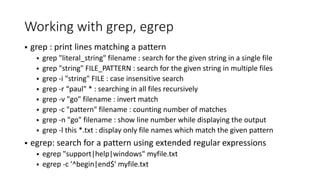This document provides an overview of Linux file management basics. It discusses permissions for files and directories, essential file management tasks like creating/moving/copying files, using text editors like Nano and Vim, performing operations like viewing file timestamps and disk usage. It also covers Linux wildcards for pattern matching, and tools for finding files like locate, find, whereis etc. I/O redirection and pipes/filters are also mentioned.
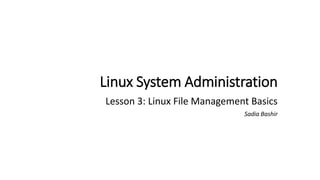

![Permissions
Permissions are the rights to act on a file/directory
Owners assign permission on every file/directory
Permissions are important to create a secure environment
What they are :
r : only open and view file/directory contents
w : modify file/directory contents
x : execute or run the file if it is a program or script
- : no read, write or execute permissions set on file/directory
= : make it the only permission
Permissions are specified for three sets of people[identities]:
owner [u] - a single person who owns the file. (typically the person who created the file but ownership may be
granted to some one else by certain users)
group [g] - every file belongs to a single group
others/all [o] [a] - everyone else who is not in the group or the owner
Note: Linux/UNIX OS has ability to multi-task and to have multiple users, who can have access to system
simultaneously, a method to protect users from each other is required. This is where permissions
come to play.](https://image.slidesharecdn.com/lesson3-workingwithfilesinlinux-170329231818/85/Lesson-3-Working-with-Files-in-Linux-3-320.jpg)
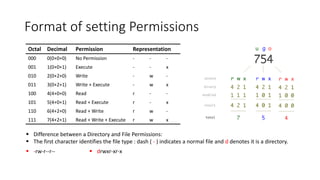
![Working with Permissions
View Permissions – ls -l [path/to/directory/file]
ls -l /home/juno/linuxtutorial/test.txt
ls -ld /home/juno/linuxtutorial
Change permissions – chmod [permissions] [path]
chmod : change file mode
chmod has permission arguments that are made up of 3 components:
changing the permission for [ugoa] - user (or owner), group, others, all
granting or revoking the permission - indicated with either a plus ( + ) or minus ( - )
Which permission are we setting? - read ( r ), write ( w ) or execute ( x )
Examples:
chmod g+x test.txt
chmod u-w test.txt
chmod ugo+wx test.txt
chmod 777 test.txt
chmd 240 test.txt](https://image.slidesharecdn.com/lesson3-workingwithfilesinlinux-170329231818/85/Lesson-3-Working-with-Files-in-Linux-5-320.jpg)

![Essential File Management Tasks
Creating a new Directory using CLI
mkdir : command to creates directories as a superuser
Syntax:
mkdir [option] [Directory_Name]
sudo mkdir mydir (creates a new directory whose parent is the current directory) OR
mkdir [option] [/home/path/to/Directory_Name]
sudo mkdir /home/juno/mydir
Options:
-m : Creates the mydir directory, and set its permissions
sudo –m a=rwx mydir
-p : mkdir will first create the parent directory /home/juno/a/b if it does not already
exists
mkdir -p /home/juno/a/b/c
rmdir : Removes empty directories – sudo rmdir /home/juno/a](https://image.slidesharecdn.com/lesson3-workingwithfilesinlinux-170329231818/85/Lesson-3-Working-with-Files-in-Linux-7-320.jpg)

![Naming [File/Directory] Conventions
A directory may have the same name as one of the items it contains
Different directories may contain files with same name
Some characters have special meanings to Unix hence it is best to avoid
using these characters in file names:
/ " ' * | ! ? ~ $ < >
Unix is case-sensitive : so each of these is a unique file: myfile, Myfile,
myFile, and MYFILE](https://image.slidesharecdn.com/lesson3-workingwithfilesinlinux-170329231818/85/Lesson-3-Working-with-Files-in-Linux-9-320.jpg)
![Rename/copy/move/delete a File/Directory
RENAME : mv FILE_NAME.txt/DIRECTORY [oldname] [newname]
FILE : mv sample.txt newsample.txt
DIRECTORY : mv sample newsample
COPY : cp FILE_NAME.txt/DIRECTORY [source] [destination]
FILE : cp sample.txt /home/juno/sample /home/juno/practice
DIRECTORY : cp testd/home/juno/sample /home/juno/practice
MOVE : mv FILE_NAME.txt/DIRECTORY [source] [destination]
FILE : mv sample.txt /home/juno/sample /home/juno/practice
DIRECTORY : mv testd/home/juno/sample /home/juno/practice
DELETE : rm FILE_NAME.txt - rm -rf DIRECTORY
FILE : rm sample.txt
DIRECTORY : rm -rf test - -r : recursively
Options : [-f: force, -i: iteratively ask before removing each sub-directory]](https://image.slidesharecdn.com/lesson3-workingwithfilesinlinux-170329231818/85/Lesson-3-Working-with-Files-in-Linux-10-320.jpg)
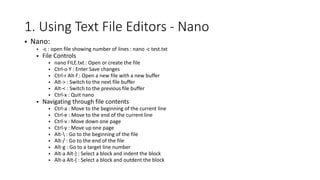

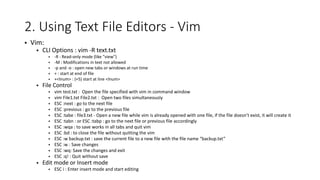

![2. Using Text File Editors - Vim (contd…)
Search and Replace
ESC /sometext and enter : Search for the word specified.
n : To find the next occurrence
N : the previous occurrence
ESC :s/foo/bar/g : search and replace “foo” with “bar” in the current line
ESC :%s/foo/bar/gc : search and prompt to replace “foo” with “bar”
ESC :%s/foo/bar/g : search and replaces all “foo” with bar in the file
ESC :%s/[0-9]/a/g : find all digits and replaces it with “a”.
Copy and Paste
ESC v : move the cursor to select the text to cut or copy
Press d : to cut OR
Press y : to copy
Press p : Move cursor to the point to paste the text and Press p to paste it
Reveal hidden Characters
:set list
:set nolist
Help
ESC :help : open help page
ESC :q : exit help page](https://image.slidesharecdn.com/lesson3-workingwithfilesinlinux-170329231818/85/Lesson-3-Working-with-Files-in-Linux-15-320.jpg)

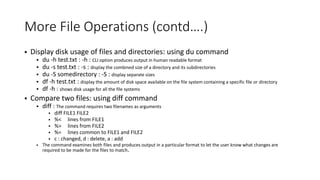
![Linux Wildcards & Pattern matching : *?[ ]
A wildcard is a character that can be used as a substitute for any class of
characters to create a “pattern” to be used in a search in order to greatly increase
the flexibility and efficiency of search
Star/asterisk (*) Wildcard : It represents zero characters, all single characters or any string, in
other words, it represents everything
ls *.txt : list down all files having .txt extension
ls n* : list all files starting with lower case letter n
rm *enw* : delete all files in a current directory having e n or w as part of their name
file * : lists type of all file system objects in current directory
wildcards can be used at any point in the path
ls -lh /home/*/.bash_history : list .bash_history file in every users home directory
Question-mark (?) Wildcard : represents exactly a single character
ls *.???
file ?.*
ls ?i*
mv public_html/*.??g public_html/images/ : move all files of type either jpg/png into another directory](https://image.slidesharecdn.com/lesson3-workingwithfilesinlinux-170329231818/85/Lesson-3-Working-with-Files-in-Linux-18-320.jpg)
![Linux Wildcards & Pattern matching (contd...)
Square Brackets Wildcard [] : represents a range of characters
file *[xyz]* : lists all objects in the current directory that have an x, y and/or z in them
ls *.[xyz]* : list all files that have an extension that begins with x, y or z
file [a-f]* : hyphen indicates a range inclusive of these two characters - this command would provide
information about all of the objects in the current directory that begin with any letter from a through f
file *[0-9]* : provide information about every object in the current directory whose name includes at
least one numeral
file [a-cx-z]* : specifies multiple sets of ranges - this command would return information about all
objects whose name begin with the first three or the final three lower case letters
ls jones[0-9][0-9][0-9] : succession of square bracket wildcards – this command would display all
filenames in the current directory that consist of jones followed by a three-digit number
ls [^a-k]* : caret ( ^ ) reverses the range, which means look for any character which is not one of the
range](https://image.slidesharecdn.com/lesson3-workingwithfilesinlinux-170329231818/85/Lesson-3-Working-with-Files-in-Linux-19-320.jpg)
![Finding Files - Locate
Locate : the quickest way to find the location of files/directories
locate [options] name(s)
When used without any options, locate displays every absolute pathname for which the user
has access permission that contains any of the names of files and/or directories that are
provided to it as arguments
locate sysctl.conf, locate updatedb.conf locate mlocate.db
Options :
-o : display all the output in one line
-c : get the count of number of matching entries
-i : perform case insensitive search
-e : check if the file is physically present in the system
-l <num> : restrict search results
Note: The ‘locate’ command is fast as it searches for file paths in a database named “mlocate.db” rather than searching from
the entire hard drive. This database is automatically updated on a regular basis by cron, which runs in background and updates
this database file at a pre-configured frequency. Hence “updatedb” command is used to manually update mlocate.db file in
order to get latest and reliable results.](https://image.slidesharecdn.com/lesson3-workingwithfilesinlinux-170329231818/85/Lesson-3-Working-with-Files-in-Linux-20-320.jpg)

![Finding Files - Find (contd…)
Find file based on file permissions irrespective of other permissions
find . -perm -g=r -type f -exec ls -l {} ; : Find files which have read permission to group
find . -perm 040 -type f -exec ls -l {} ; : Find files which have read permission only to group [ search by octal ]
find . -perm g=r -type f -exec ls -l {} ; : Find files which have read permission only to group
Find empty files
find ~ -empty : find all empty files in home directory
find . -maxdepth 1 –empty : List all the empty files only in home directory
find . -maxdepth 1 -empty -not -name “.*“ : List only the non-hidden empty files only in the current directory
Find Files Based on file-type
find . -type d : Find all directories
find . -type f : Find normal files only
find . -type f -name ‘.*’ : Find hidden files
find -type d -name ‘.*’ : Find hidden directories
Find Files by Size : - means less than the give size, + means more than the given size, and no
symbol means exact given size
find ~ -size +100M
find ~ -size -100M
find ~ -size 100M](https://image.slidesharecdn.com/lesson3-workingwithfilesinlinux-170329231818/85/Lesson-3-Working-with-Files-in-Linux-22-320.jpg)
![Finding Files - whereis, which, whatis
whereis : command to locate the binary, source, and manual page files for a
command
Usage: whereis [-options]
whereis -b whereis : Locate binaries for a command
whereis -m whereis : Locate man pages for a command
whereis -B /bin -f chmod : Locate binaries in a specified path
whereis -M /usr/share/man/man1 -f open : Locate man pages with limited scope
which : simple command to locate executables in the system.
It allows user to pass several command names as arguments to get their paths in the system,
searches the path of executable in system paths set in $PATH environment variable
Usage: which [-option]
which ls open chmod grep
which -a echo : display all paths
Whatis : displays brief information for command that matches the argument
passed to it
whatis [-options] : whatis ls, whatis cat, whatis cd etc.](https://image.slidesharecdn.com/lesson3-workingwithfilesinlinux-170329231818/85/Lesson-3-Working-with-Files-in-Linux-23-320.jpg)
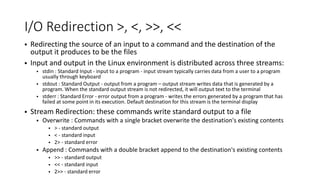



![Using Common Text Manipulation Tools(contd….)
tr : The tr command is used to translate characters from stdin, displaying them on stdout. In its
general form, tr takes two sets of characters, and replaces characters from the first set with
characters from the second set
tr pre-defined character classes:
alnum - alphanumeric characters
alpha - alphabetic characters
blank - whitespace characters
cntrl - control characters
digit - numeric characters
graph - graphic characters
lower - lower-case alphabetic characters
print - printable characters
punct - punctuation characters
space - space characters
upper - upper-case characters
xdigit - hexadecimal characters
Examples:
echo "Who is the standard text editor?" |tr [:lower:] [:upper:] - Upper-case a string
echo 'ed, of course!' |tr -d aeiou - delete characters from a string
echo 'The ed utility is the standard text editor.' |tr -s astu ' ‘ - translate characters to a space
echo 'extra spaces – 5’ | tr -s [:blank:] - -s option flag is used to suppresses extra white space in a sting](https://image.slidesharecdn.com/lesson3-workingwithfilesinlinux-170329231818/85/Lesson-3-Working-with-Files-in-Linux-28-320.jpg)
